SaaS Content Marketing
10 mins read
A 9-Step Formula to Craft SaaS Content that Converts (No MQLs)
Insights on how to create content that converts users
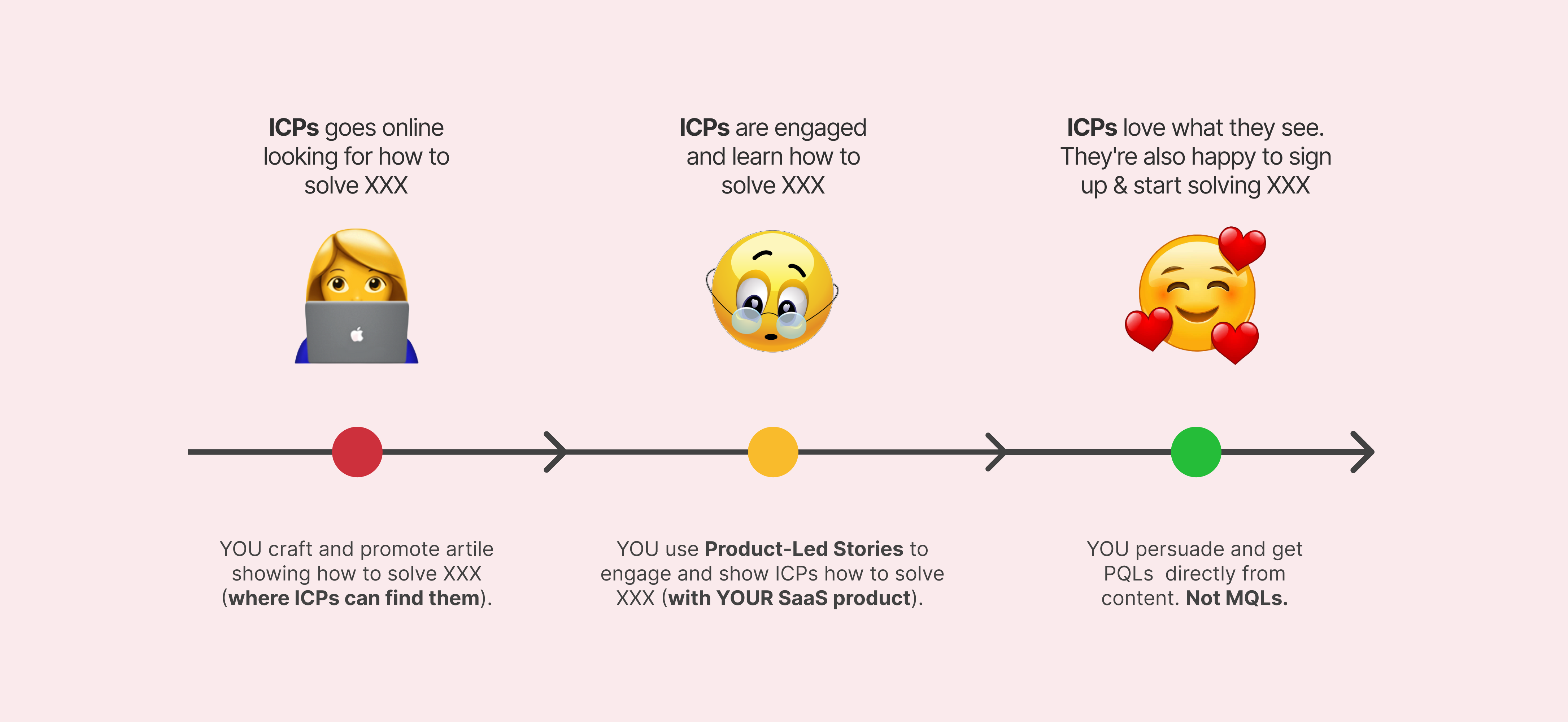

Victor Eduoh
Lead Strategist @VEC
“[Wow!] $40 Million ARR in 2018 is an enviable milestone [man]”
Si Quang Ong, then at Leedfeeder, expressed excitedly.
“So tell me, how do those many customers find your SaaS product?”
Si Quang managed to shrug off the excitement and nail the 1-million-dollar question on its head.
“How they find us?”
Tim Soulo, Ahrefs’ CMO, presumably retorted as he began to gather his thoughts. But, he didn’t’ think thrice when he almost exclaimed:
“For most of our new users, when they sign up, they tell me: I read your articles. I saw how you use Ahres for this, and this made me sign up!”
In order words, to get new users and drive growth, most of what Ahrefs does is getting people to find and read their articles.
No wonder it is the:
“…second best marketing channel sending them hundreds of new users per month:”
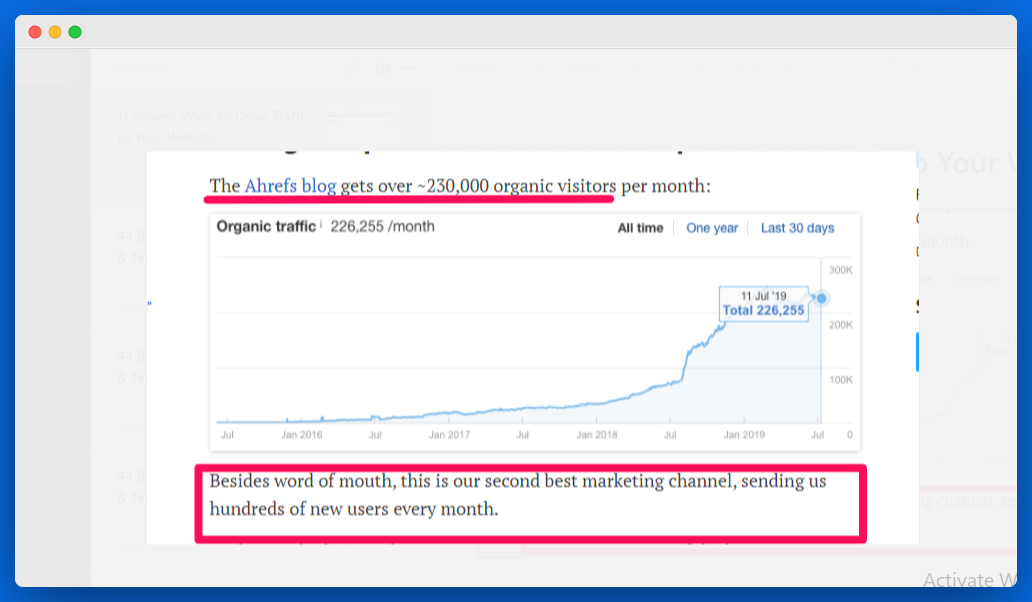
Hhmm… doesn’t sound simple and straightforward in reality, right?
If you’re curious, I was also dead curious when I first saw that interview.
But, you’re in luck because I didn’t let my curiosity go unattended.
I dug deep. I wanted to unravel the secret tonic in Ahrefs’ articles that makes them convert random visitors directly into new users on autopilot.
No “leads.” “No MQLs.”
And secret tonic, I did find.
In another report, Tim Soulo revealed it:
“Each [Ahrefs] article is a “sales page” in disguise that shows readers how to solve the issue they were searching for with the help of our product.”
Good enough, he wasn’t lying. Here’s a new user who even tweeted about it:

So far, here’s what all of this is telling me (and you):
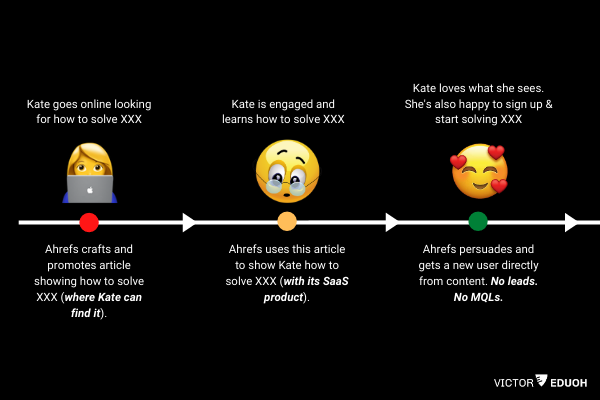
[source]
Pretty explanatory, right?
Yes. And it works.
Two years after Tim gave that interview, Ahrefs are now above $50 million ARR.
Two years after Tim gave that interview, Ahrefs are now above $50 million ARR.
Thus, using what seems like a straightforward, content-direct-to-new-user process, Ahrefs turned its articles into:
- “Disguised” sales pages, and
- High-converting funnels.
But let me tell you the truth.
That process is only straightforward from afar. Digging even deeper, I went in search of any other prominent factor that makes it possible.
Guess what I found?
The same reason why you’re still reading this particular one…
Stories!
Now, let’s face it.
Online, your prospects’ attention spans (like yours) are nothing to write home about. It went down from 12 to 8 seconds in just two decades.
Yes, only 8 seconds. That’s all you got to capture people’s attention.
And the only way to engage and hold that attention until they convert?
A good story.
To be precise, a mutually-beneficial one. Isn’t that why you’re still reading this one?
Haha!
A good story is the other significant piece of the puzzle.
It is what makes Ahrefs and other SaaS companies’ content pieces convert readers directly into new users.
Again, no “leads.” “No MQLs.”
So, to develop all the steps (and formula) you need to craft SaaS content that converts, I investigated SaaS brands doing magic with storytelling.
Did I find them?
Yes, a handful, but one stood out for me:
Alex Turnbull’s GrooveHQ.
Around 2014, GrooveHQ’s business almost sank, according to Alex, the company’s Founder and CEO.
After careful review, GrooveHQ realized the only way out was to go all-in on SaaS content marketing. But, it wasn’t the regular kind of content marketing that saved them.
It was one hinged on storytelling.
In short, a touch of storytelling and their blog engagement skyrocketed over 300%:
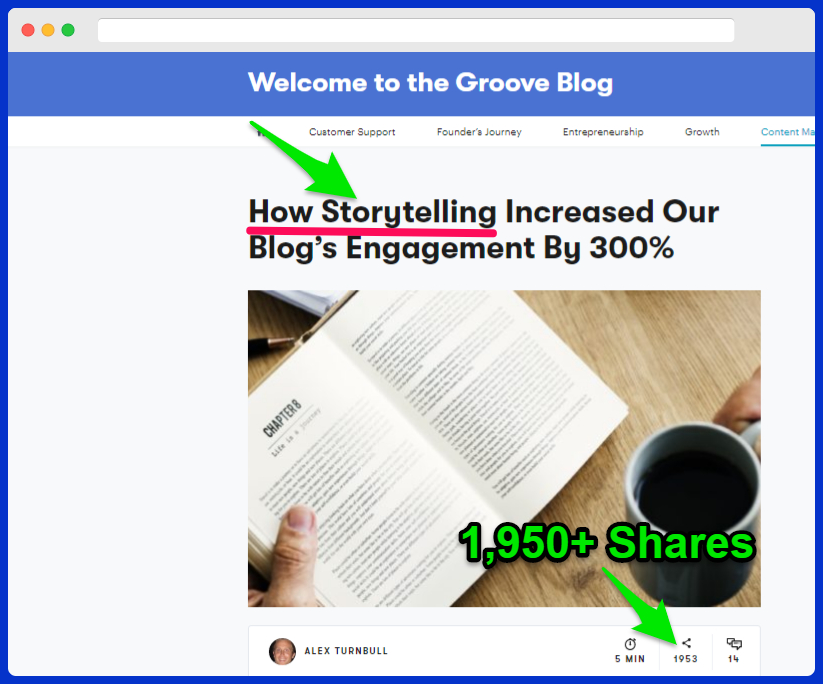
[GrooveHQ]
It wasn’t only engagement that skyrocketed. Time On Page (what you need to hold people’s attention until they convert) also ballooned over 519%:

[GrooveHQ]
The most exciting thing?
As you see in the screenshot above, these high-converting content pieces offered the same value.
The only difference?
Stories!
And the result of using storytelling to drive its SaaS content marketing?
From almost going bankrupt and out of business, GrooveHQ went up to $5 million ARR under three years:
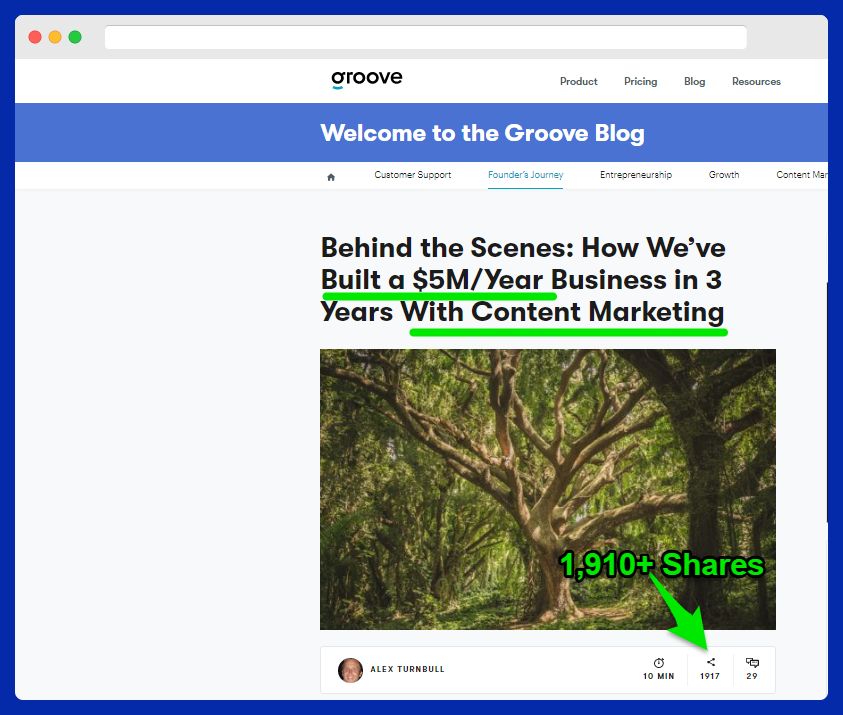
[GrooveHQ]
In case you missed anything, this is what GrooveHQ’s case looks like:
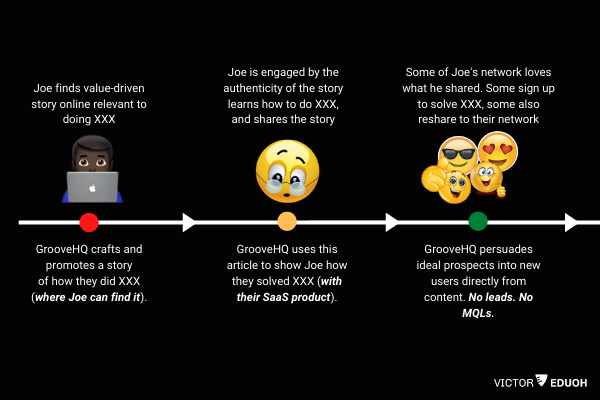
[source]
Now, let’s have a recap.
Using GrooveHQ and Ahrefs, as our examples, your SaaS content pieces would convert readers directly into new product users if they:
- Get found by those looking to solve the problem each article addresses.
- Hold readers’ attention and engage them with storytelling while showing them how to solve that problem with your product.
- Continue holding their attention with storytelling, while persuading them to sign up and solve that problem with your product, that moment.
When your SaaS content meets those criteria, they turn into “disguised sales pages,” according to Tim Soulo.
And what does that tell you?
It tells you that your content pieces become the tool that funnels readers into new product users.
In order words, no more need for “leads” or “MQLs.” And if that’s the case, you might as well do away with what generates “MQLs:”
The traditional, lead-generating obsessed sales funnel.
So, what would funnel-like content pieces look like?
The exact ones used by journalists since time memorial to create viral news articles:
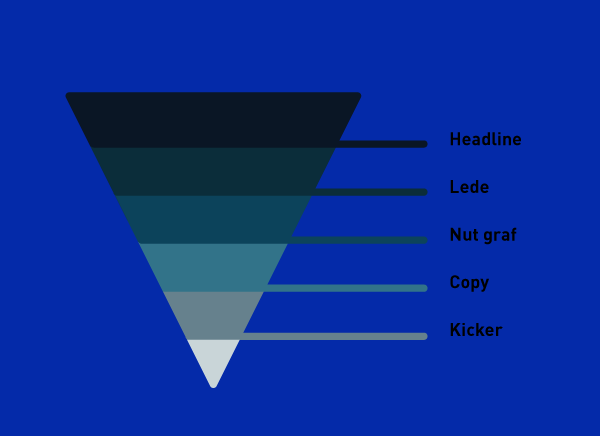
[source]
Also called the article template in journalism, the upside-down or inverted triangle is one of the simplest things they teach journalists.
The design of this template is to:
- Maximize an article’s attractiveness (or appeal).
- Start with the information that speaks to the broadest audience at the top.
- Reserve the info that speaks to the least and most targeted audience at the bottom.
- Towards that bottom, the “copy” and “kicker” combine to serve one purpose: Get the reader to take action or lean in favor of the news the article discussed.
The end goal of this template?
To attract the widest audience, while news piece’s depth passes information to a specific audience – those who’ll read it to the end:
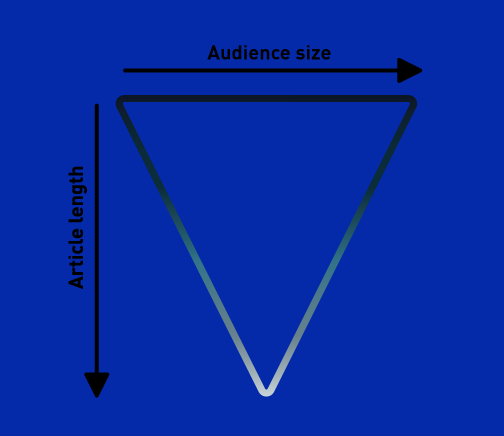
[source]
Do you love what you’ve seen so far?
Would you like your SaaS content to generate new product users 24/7 without the back and forth, chasing email addresses tagged as “leads”?
Then, you’ll love the 9-step Product-Led Storytelling formula I developed for crafting high-converting SaaS content pieces.
After extensive research, I blended what Ahrefs, GrooveHQ, many other SaaS companies do to drive growth via content marketing.
Then, I mirrored journalism’s inverted triangle to develop this formula.
Goldfishes don’t hide, as they say.
In the same vein, my developed framework for converting content pieces into funnel-like tools couldn’t hide.
Few weeks after I published about it, “experts” bought into my idea for the next generation of SaaS customer acquisition via content marketing.
How, you ask?
This formula was the single biggest reason the Product-Led Institute invited me to Speak at its annual summit:
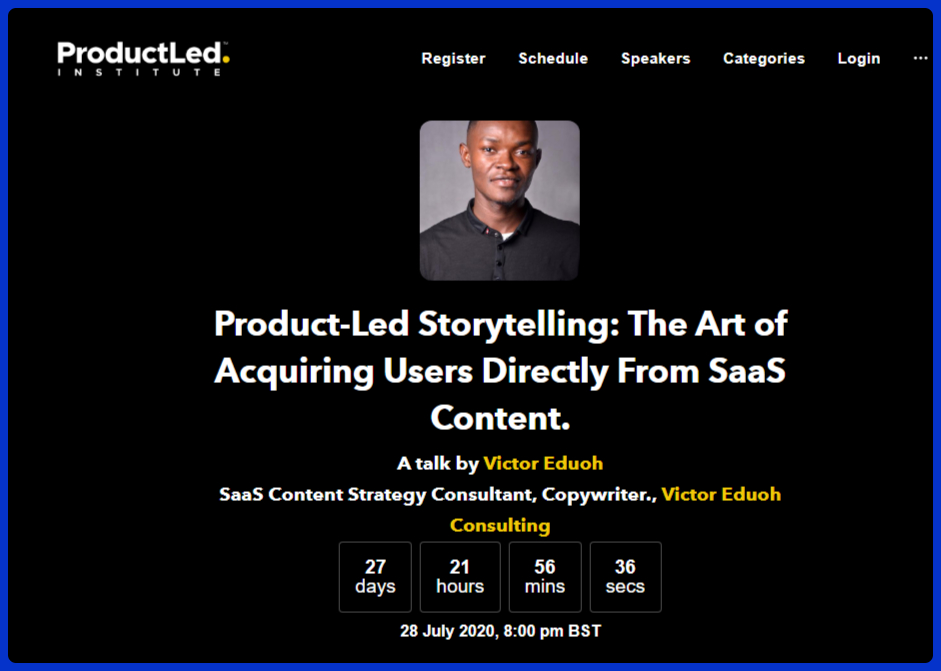
[You can sign up for my talk here]
It was also the first time in my career I got lined up with over 150 top professionals I could only admire from afar:
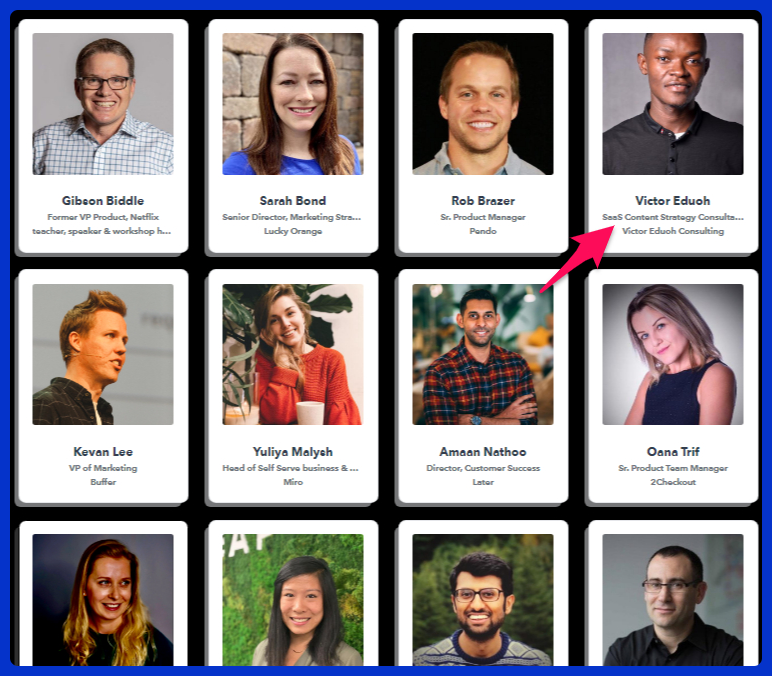
If they saw it fit for me to tell the SaaS product community about it, you can do much better with your SaaS content pieces if you apply this formula.
So, ready to learn and apply this framework to up your SaaS customer acquisition game via content?
Good.
First, let’s define Product-Led Storytelling.
What is Product-Led Storytelling?
“At its core, it is a product-focused type of content marketing.
In more detail, it is the art of crafting discoverable stories. With each showing (and not telling) how your well-defined ICP (ideal customer personas) can overcome specific challenges, using your SaaS product.”
I coined this term, so as per my definition, it breaks down into three areas:
- Craft discoverable stories with a broad appeal, but tailored to defined ICPs.
- In those stories, show (don’t tell) with uses cases, screenshots, workflows, etc. how your product solves the problem addressed in each.
- Apply subtle SaaS copywriting to persuade and convert readers engaged to the finish line via storytelling. Your CTA must be specific by asking them to sign up (or request a demo) to use your product and start solving the problem each article addressed.
When you apply this formula, would all your content pieces generate new product users on the same scale as you generated “leads” or ”MQLs”?
No.
But, you’ll get people more qualified to become long-term customers, as Lessonly discovered:
“And it took a lot of energy for us to just say we’re okay with getting fewer leads. But what we’ve found is that we’re actually getting more than what we thought, and they’re more qualified.”
Sharing how this mindset shift helped them drive growth, Lessonly’s CMO, Kyle Lacy also added:
“There’s just way too many competitors; the market is wide open. It’s your ability to tell a story that delivers a different value to somebody than just a feature set…
…If you can tell a story differently, they’re going to listen to you. And we just happen to be able to tell a story differently in a way that works.”
So, again, another pointer, proving Product-Led Storytelling works.
And as Neil Patel discovered after he surveyed 183 companies, the number of visits to your blog before one becomes a customer continues to shrink:
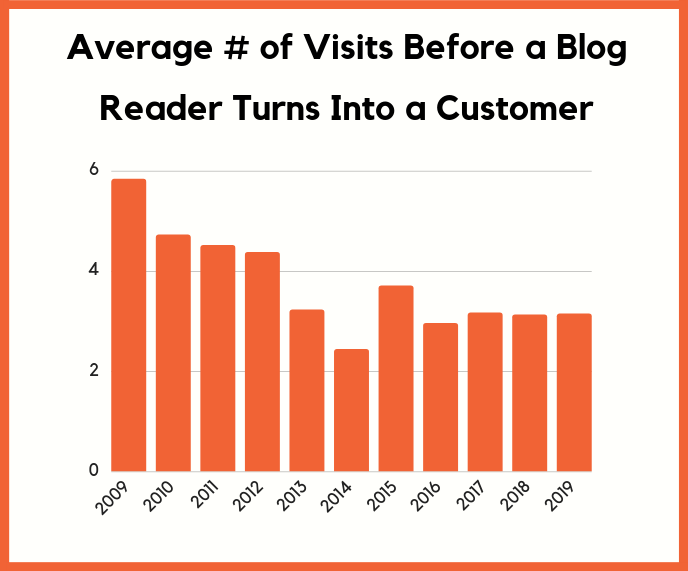
[source]
In order words, you have fewer opportunities via content to persuade and convert blog readers into customers.
And to make those fewer opportunities count, the Product-Led Storytelling formula comes in handy.
The reason is that with this framework, you could convert new users after they read just one of your content pieces.
See it for yourself:
The 9-Step Product-Led Storytelling Formula
This formula is the thoughtful creation and layout of SaaS content pieces, aiming to engage well-defined ICPs and turn them into product users.
It goes thus:
- Craft benefits-driven stories that promise to solve a problem for them. In order words, prospects should see value in your title.
- Get the context straight right off the bat. Your content mustn’t appeal to everyone. It should target defined ICPs who’ll get the most value from your product-led story.
- Show (and not tell) them your product can solve the problem addressed in the article, which gets keen on exploring your content.
- Make your content entertaining and engaging by infusing your PoV, quotes, stats, etc. Walk prospects through how to solve the problems your article addresses in real-time using relevant stories.
- Insert reviews and contextual CTAs, inviting those who consume your content up to this point to start solving their problems with your tool.
- Add more entertaining stories, as necessary. But, make sure you continue to insert snapshots of your tool in action.
- Use a more-detailed testimonial (with a reasonable outcome) to show that people similar to the ICPs your content targets have used your tool to achieve results.
- Switch on your SaaS copywriting skills and persuade those who engaged your content to this concluding part. Get them to imagine how their lives will be better if they signed up and started using your tool to solve the problems your product-led story walked them through.
- Don’t ask them to become a lead, download an ebook, or use a pop up to disrupt them. Use a prominent CTA box, sweet copy, and button and ask them to trial/demo your product.
In the end, your content layout like this:

[source]
Followed to the letter, each content piece you create following this formula transforms into a funnel that converts prospects into new users.
Remember journalism’s inverted triangle I shared earlier?
This content funnel takes that shape, but with nine sections grouped into the three areas, defining the Product-Led Storytelling formula:

[source]
And the result of approaching SaaS content creation, using this framework?
As you can see in the illustration above, instead of generating email addresses hoped to be “leads,” you’ll get PQLs (product-qualified leads).
According to Wes Bush, Founder of the Product-Led Institute, PQLs are better:
“Product-Qualified Leads (or PQLs for short) are more likely to become customers than other leads.
Unlike Marketing Qualified Leads (MQLs), which base buying intent on arbitrary factors like email opens, whitepaper downloads, and webpage visits, PQLs are tied to a meaningful value.”
The gains of this approach don’t end there.
As new users join your userbase after enjoying your product-led story, you can do away with the back and forth, moving customers between teams.
In order words, no more would the marketing team generate email addresses and send to your sales teams as “leads” or “MQLs.”
And no more would your sales team waste time and resources, chasing and trying to close people who downloaded an ebook they never opened.
Everyone can now focus on what I term The Single Point of Truth: The Product and The Customer:
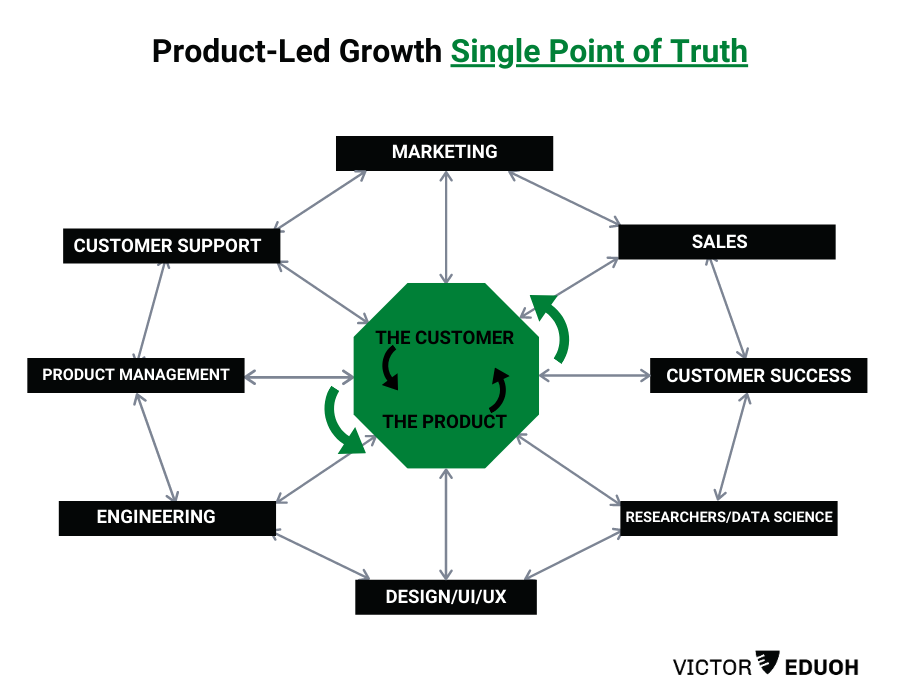
[source]
Conclusion: Can I Apply this Framework on My Own?
You can.
But, as with any successful SaaS customer acquisition motion, you need a rigid strategy guide.
And for that, I also created a unique one suitable for this highly-competitive Product-Led Growth era.
I call it the SaaS Content Topic Clusters Strategy:
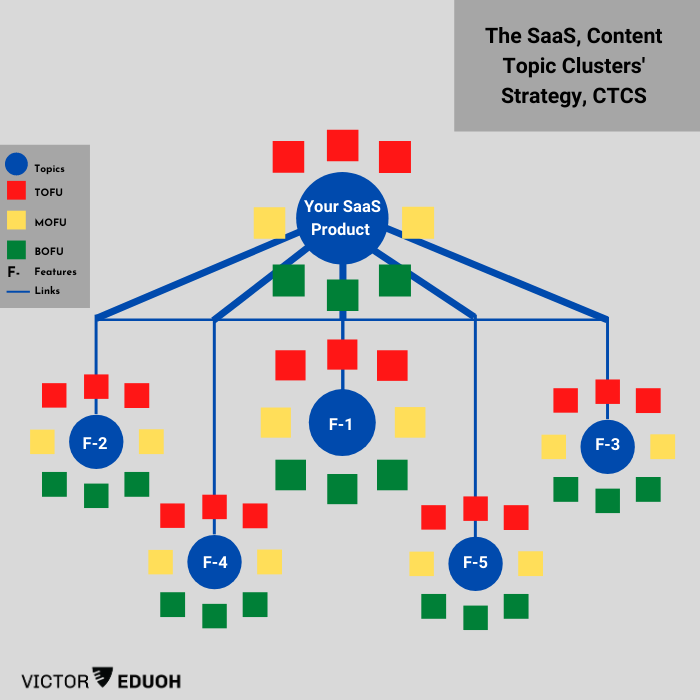
[source]
This unique strategy does two things exceptionally:
- It empowers you to
- Also, it gives you direction to know what queries your content pieces should cover.
For example, let’s say you own a SaaS product with an ai sales feature.
This strategy guides to build a solid cluster of content on this feature. Thereby increasing your chances of ranking higher and driving better-qualified traffic, as you’ll build a robust internal structure:
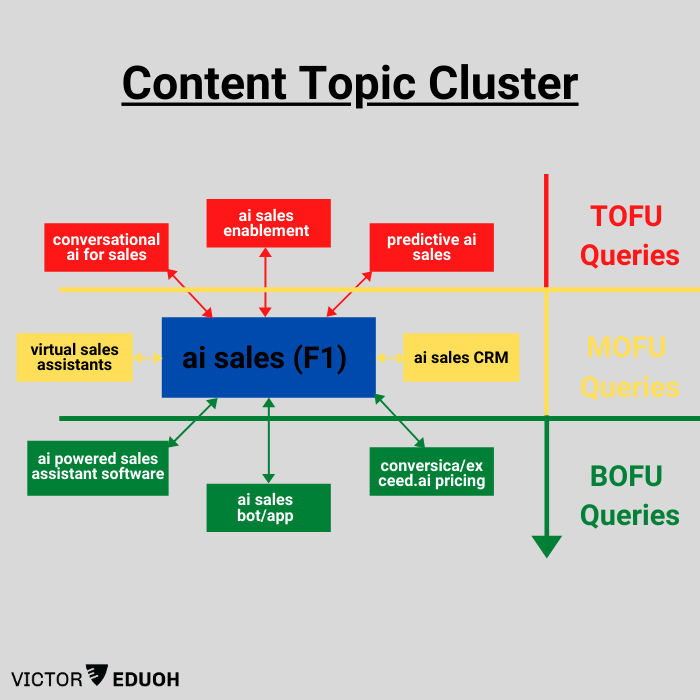
You’ll also need high-level SaaS copywriting skills.
As I’ve shown you so far, your content’s goal is to engage and convert.
And copywriting is what enables you to structure the flow of content until you achieve that.
Finally, you’ll need good storytellers.
This is one area both GrooveHQ and Ahrefs don’t leave to chance.
GrooveHQ hires storytellers:
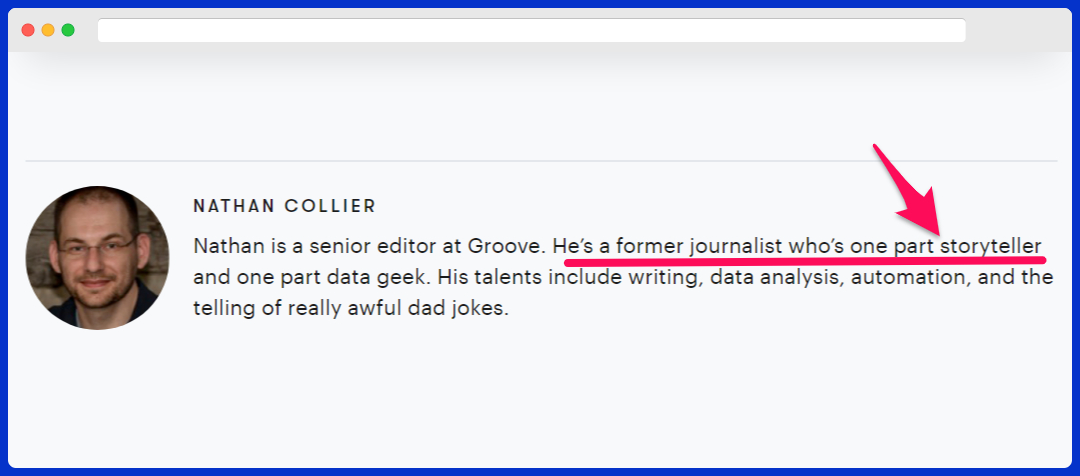
[GrooveHQ]
Ahrefs does the same:
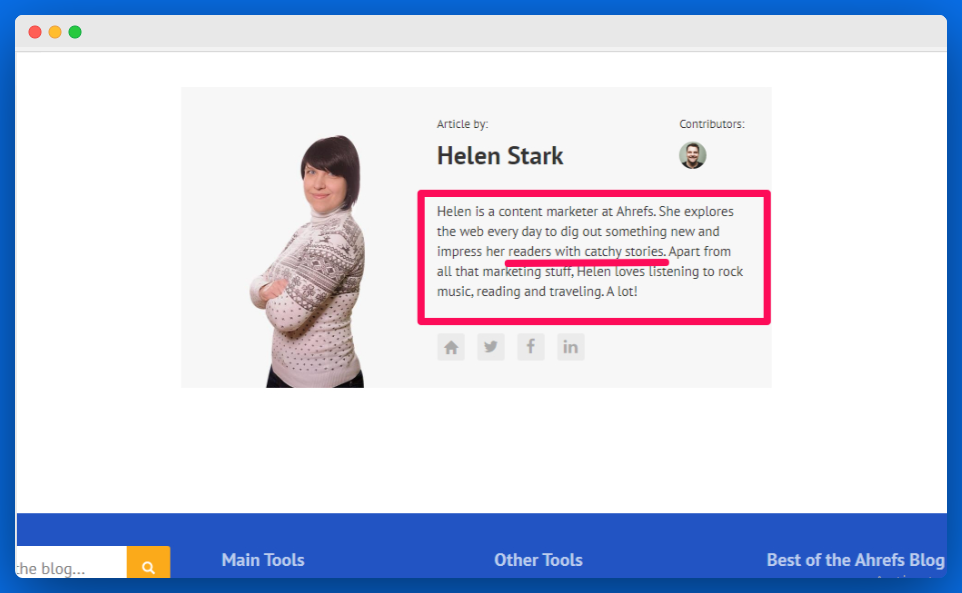
[Ahrefs]
But, what if you don’t have all of these firepowers at your fingertips?
You have a couple of options:
- Contact me to help you
- Download our exhaustive Product-Led Storytelling guide (over 7,700 words) below:

Victor Eduoh
Lead Strategist @VEC
Founder, Lead Strategist @VEC. Thinker, reader, words-crafter, and husband to Omosede. Besides crafting product-led stories, I love scouting and grooming rare marketing talents.
Rare insights, in your inbox
How do SaaS Founders and B2B Content Leaders build brand and drive growth through story-driven content execution? Dig that, plus rare Product-Led Storytelling insights, in this bi-weekly newsletter.
Get a copy of our Story-driven, Content Quality Checklist –FOR FREE– once you subscribe.

